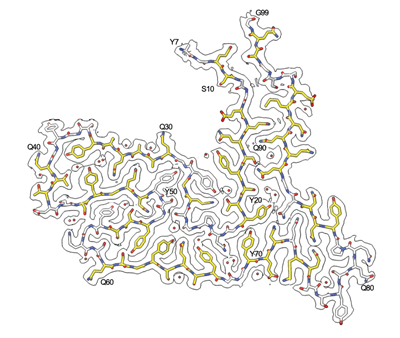Discovery could lead to new, targeted therapeutics for frontotemporal dementia
INDIANAPOLIS—An international team of researchers including experts at the Indiana University School of Medicine has identified a protein found in the brains of people with frontotemporal dementia (FTD), discovering a new target for potential treatments for the disease.According to the National Institutes of Health, FTD results from damage to neurons in the frontal and temporal lobes of the brain. People with this type of dementia typically present symptoms, including unusual behaviors, emotional problems, trouble communicating, difficulty with work or in some cases difficulty with walking, between the ages of 25 and 65.
Neurodegenerative disorders, including dementias and Amyotrophic Lateral Sclerosis (ALS), occur when specific proteins form amyloid filaments in the nerve cells of the brain and spinal cord. The multidisciplinary team of researchers—including members from the Medical Research Council (MRC) Laboratory of Molecular Biology, the IU School of Medicine and the University College London Queen Square Institute of Neurology—found that in cases of FTD, a protein called TAF15 forms these amyloid filaments in the cells of the brain and the spinal cord. On Dec. 6, they published their findings in Nature.
 Bernardino Ghetti, MD is a Distinguished Professor at the IU School of Medicine and has been studying neurodegenerative dementias for 50 years. As a lead neuropathologist on the project, Ghetti and his team studied the protein aggregates from brains donated by four people who had frontotemporal dementia and motor weakness. Together with their colleagues in the UK, IU researchers used neuropathologic and molecular techniques and cutting-edge cryo-electron microscopy (cryo-EM) at atomic resolution to discover the presence of the amyloid filaments made of TAF15 protein in multiple brain areas. However it is important to note that TAF15 amyloid affects also nerve cells of the motor system.
Bernardino Ghetti, MD is a Distinguished Professor at the IU School of Medicine and has been studying neurodegenerative dementias for 50 years. As a lead neuropathologist on the project, Ghetti and his team studied the protein aggregates from brains donated by four people who had frontotemporal dementia and motor weakness. Together with their colleagues in the UK, IU researchers used neuropathologic and molecular techniques and cutting-edge cryo-electron microscopy (cryo-EM) at atomic resolution to discover the presence of the amyloid filaments made of TAF15 protein in multiple brain areas. However it is important to note that TAF15 amyloid affects also nerve cells of the motor system.“This discovery represents an important breakthrough that recognizes TAF15 as a potential target for the development of diagnostic and therapeutic strategies toward a lesser-known form of frontotemporal lobar degeneration associated with frontotemporal dementia,” Ghetti said.
Additional authors on the study are the MRC Laboratory of Molecular Biology’s Stephan Tetter, Diana Arseni, Alexey G. Murzin, Sew Y. Peak-Chew and Benjamin Ryskeldi-Falcon; the University College London’s Yazead Buhidma and Tammaryn Lashley; and the IU School of Medicine’s Holly J. Garringer, Kathy L. Newell, Ruben Vidal and Liana G. Apostolova.
The study was in part funded by the NIH’s National Institute on Aging and National Institute of Neurological Disorders and Stroke.
About IU School of Medicine
IU School of Medicine is the largest medical school in the U.S. and is annually ranked among the top medical schools in the nation by U.S. News & World Report. The school offers high-quality medical education, access to leading medical research and rich campus life in nine Indiana cities, including rural and urban locations consistently recognized for livability.




